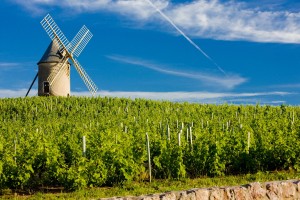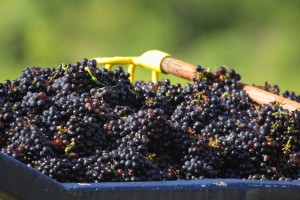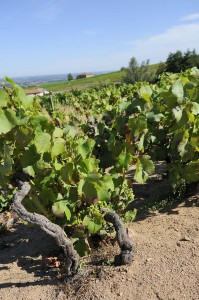“If any Beaujolais can outlast a dog and grow in stature with the years, it is the wine grown on the crunchy, rust-pink sands which anchor this windmill, this Moulin-à-Vent.”
Andrew Jefford, The New France
 What a great quote, from Andrew Jefford. It’s so good that I did not even attempt to write a better introduction to today’s post, which, by the way, is written with a tip of the hat to today’s world-famous release of Beaujolais Nouveau. But instead of focusing on the party drink of the day, I thought we’d look at Moulin-à-Vent, considered to be the most noteworthy of the ten Crus of Beaujolais.
What a great quote, from Andrew Jefford. It’s so good that I did not even attempt to write a better introduction to today’s post, which, by the way, is written with a tip of the hat to today’s world-famous release of Beaujolais Nouveau. But instead of focusing on the party drink of the day, I thought we’d look at Moulin-à-Vent, considered to be the most noteworthy of the ten Crus of Beaujolais.
The appellation Moulin-à-Vent, located just around the middle of the northern section of Beaujolais shared by the ten Crus, sits just south of Chenas and to the north and east of Fleurie. As there is no actual town named Moulin-à-Vent, the vineyards themselves are located in either the commune of Romanèche-Thorins or Chénas. The name Moulin-à-Vent comes from on old windmill standing to the northwest of Romanèche-Thorins, now preserved as the last remaining specimen in the Beaujolais region.
 The richness, full-flavor, and longevity of Moulin-à-Vent can be traced, at least in part, to the unique soil of the region. The soil here is a pink crumbly granite with a uniquely high level of the mineral manganese. This is toxic to the grape vines; not enough to kill the vines, but enough to cause chlorosis, a vine disease that reduces the ability of the plant to produce insufficient chlorophyll. This alters the vine’s metabolism enough to severely reduce yields and contributes to grapes with intense, concentrated flavors.
The richness, full-flavor, and longevity of Moulin-à-Vent can be traced, at least in part, to the unique soil of the region. The soil here is a pink crumbly granite with a uniquely high level of the mineral manganese. This is toxic to the grape vines; not enough to kill the vines, but enough to cause chlorosis, a vine disease that reduces the ability of the plant to produce insufficient chlorophyll. This alters the vine’s metabolism enough to severely reduce yields and contributes to grapes with intense, concentrated flavors.
Young Moulin-à-Vent tends to have the cherry-berry-smoky-spice aromas and flavor profile typical of Beaujolais, with a bit more tannic structure and even a hint of oak (and definitely minus the banana candy-bubbly gum profile often seen in Nouveaus). However, with age, the finest examples can mellow…many people say that Moulin-a-Vent is best consumed at around six years old, and some can be cellared for 10 to 20 years.
As the wines age, they lose some of their fresh fruitiness, and develop more Pinot-like  characteristics. You could say that as they age they start to resemble Pinot Noir. There’s even a word for this process: Pinoter. The definition for “Pinoter,” if you can believe it, is to “develop Pinot Noir-like characteristics with age.”
characteristics. You could say that as they age they start to resemble Pinot Noir. There’s even a word for this process: Pinoter. The definition for “Pinoter,” if you can believe it, is to “develop Pinot Noir-like characteristics with age.”
You might see the term ““fûts de chêne,” meaning “oak casks” on the label of an oak-aged Moulin-à-Vent. In addition, the following lieu dits can be added to the label: Les Carquelins, Les Rouchaux, Champ de Cour, En Morperay, Les Burdelines, La Roche, La Delatte, Les Bois Maréchaux, La Pierre, Les Joies, Rochegrès, La Rochelle, and Les Vérillats.
I read through about 100 wine reviews (and tasted one outstanding version of Moulin-a-Vent, the Domaine Diochon 2011) while researching this post, and found the following tasting terms to be the most used: rose aromas, touch of mineral, violets, cherries, raspberry, blackberry, well-structured, complex, elegant…and my favorite, “piercingly fragrant.”
Click here to return to the SWE Website.